~by Ashwini Wadhu and Saurabh Purohit
This blog is supported by HSBC Software Development (India) Private Limited under the ‘Nature-based Solutions for Sustainable Rural Landscapes and Climate Resilience’.
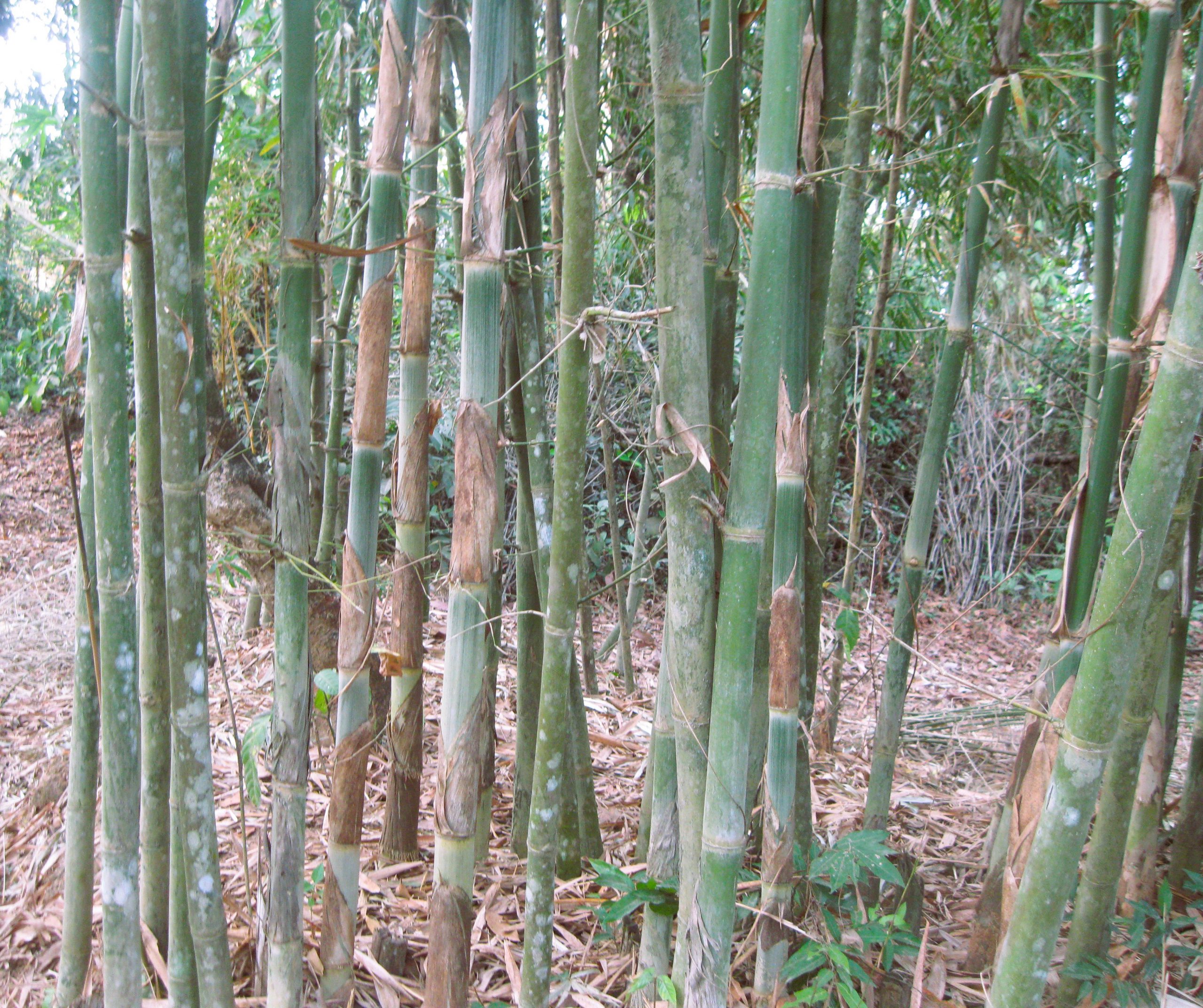
Photo Credit: Ashwini Wadhu
Bamboo, a remarkably versatile and swiftly growing member of the grass family, Poaceae, falls within the Bambusoideae subfamily. Distinguished by its woody culms, robust rhizomes, rare flowering, and intricate branching patterns, this unique plant boasts a vast global presence. Over 1,500 species of bamboo, classified into 123 genera, populate 35 million hectares across the world (Ahmad et al. 2021).
India ranks as the second-largest bamboo producer after China, cultivating 125 native and 11 non-native species within 23 genera (ISFR 2021) (Fig 1). The plant thrives in nearly all Indian states, excluding Kashmir, and in diverse environments ranging from towering mountains to fertile alluvial plains, spanning temperate to tropical regions. Bamboo’s myriad applications have earned it numerous monikers such as “Green Gold,” “Poor Man’s Timber,” “Cradle to Coffin Timber,” and “Vegetable Steel.”
With such a diverse range of application to its name, bamboo has great potential as a Nature-based Solutions (NbS) tool for achieving many SDGs, both directly and indirectly. For instance, bamboo serves as a component of disaster-resilient infrastructure, contributes to poverty alleviation through green livelihoods, revitalizes rural areas, and offers numerous environmental benefits.
Unlocking Bamboo’s myriad of Ecosystem Services
Bamboo offers a wealth of Ecosystem Services (ESs) (Shinohara et al. 2014), which contribute to sociocultural, economic, and ecological value for both local and global stakeholders. These services can be categorized as follows:
Provisioning Services:
- Food: For centuries, bamboo shoots have played a crucial role in providing food security and nutrition around the world.
- Forage: The leaves of bamboo serve as a valuable source of livestock feed.
- Timber and other products: A wide array of bamboo species are employed in the production of various materials and goods. These include raw building materials (Fig 2a), modern engineered bamboo products (Fig 2b), composite panels, boards, and construction timber.
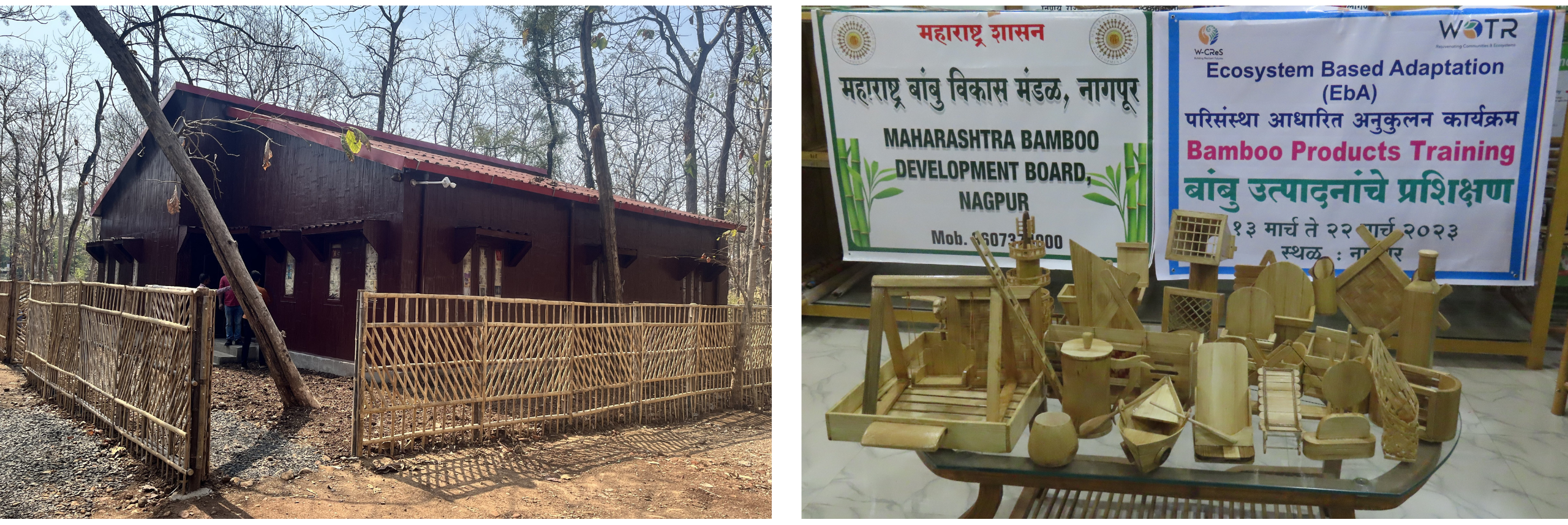
- Bioenergy: Historically, bamboo has been a reliable source of domestic energy, serving as an alternative to wood charcoal and mineral coal (Fig 3a). Additionally, bamboo waste can be repurposed into pellets and chips, which serve as clean energy sources (Fig 3b).
- Medicinal and Cosmetic Use: Bamboo holds a significant position in traditional ecological knowledge systems and is widely used for its medicinal properties. Moreover, it has become an integral component in the Korean cosmetics industry.
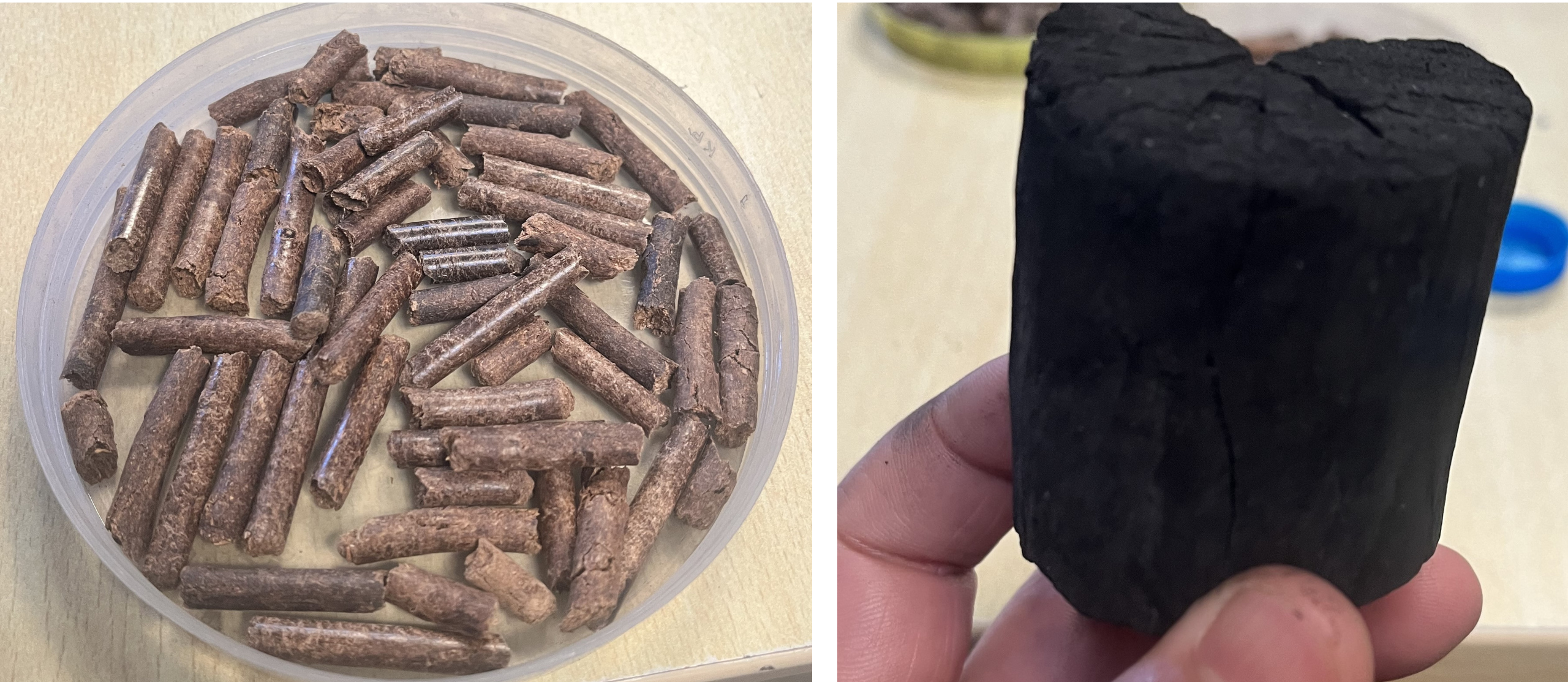
Photo Credit: Saurabh Purohit
Regulating Services
- Landscape Restoration: Owing to its rapid growth, bamboo plantations are ideally suited for rejuvenating degraded land.
- Sediment Retention: Bamboo’s robust root system stabilizes slopes and aids in reducing soil erosion.
- Carbon Sequestration: Bamboo’s fast growth rate allows it to sequester carbon more quickly than other species.
- Air Quality and Local Climate Regulation: The leaves of bamboo plants filter pollutant gases, thereby helping to improve air quality and local climate conditions.
- Flood and Landslide Control: The intricate network of bamboo rhizomes and roots binds soil particles together, mitigating the impact of floods and landslides.
- Groundwater Recharge: Bamboo slows down runoff rates and enhances water percolation, contributing to groundwater recharge.
- Water Purification: Bamboo assists in reducing organic waste through soil and subsoil filtration.
- Moderation of Extreme Events: By creating a buffer against strong winds, storms, and landslides, bamboo helps to lessen the impact of extreme events.
Cultural Services
- Landscape Aesthetics: Bamboo is a popular choice for landscape planning due to its natural beauty.
- Recreation and Ecotourism: By enhancing greenery and scenery, bamboo fosters opportunities for recreation and ecotourism within landscapes.
- Cultural and Religious Significance: Bamboo holds a special place in numerous cultural and religious communities.
Supporting Services
- Nutrient Cycling: Bamboo plays a vital role in the nutrient cycling process within the soil.
- Primary Production: Bamboo-dominated forests exhibit a higher Net Primary Production (NPP) compared to other forest ecosystems (Shimono et al. 2022; Song et al. 2017).
- Habitat and Biodiversity: Serving as a habitat for various plants and animals, bamboo contributes to the enhancement of biodiversity by supporting other species.
Bamboo’s Connection to Sustainable Development Goals (SDGs)
Bamboo is closely linked to numerous SDGs, and some of the directly related goals are highlighted below (Fig 4):
- SDG 1 (No Poverty): Bamboo species can be harnessed to create various products, generating green livelihoods for communities and helping to eradicate poverty.
- SDG 7 (Affordable and Clean Energy): Bamboo serves as a sustainable source of affordable, clean energy in the form of pellets, chips, and wood charcoal, reducing carbon emissions in developing countries.
- SDG 11 (Sustainable Cities and Communities): The high strength and flexibility of bamboo make it an ideal building material. Its sustainability, abundance, and carbon-negative properties (Manandhar, Kim, and Kim 2019) position it as a preferred choice for constructing sustainable cities. Studies have also demonstrated bamboo’s suitability for flood-resilient structures (Das and Mukhopadhyay 2018) and its excellent mechanical and anti-seismic properties (Galmarini, Costa, and Chiesi 2022).
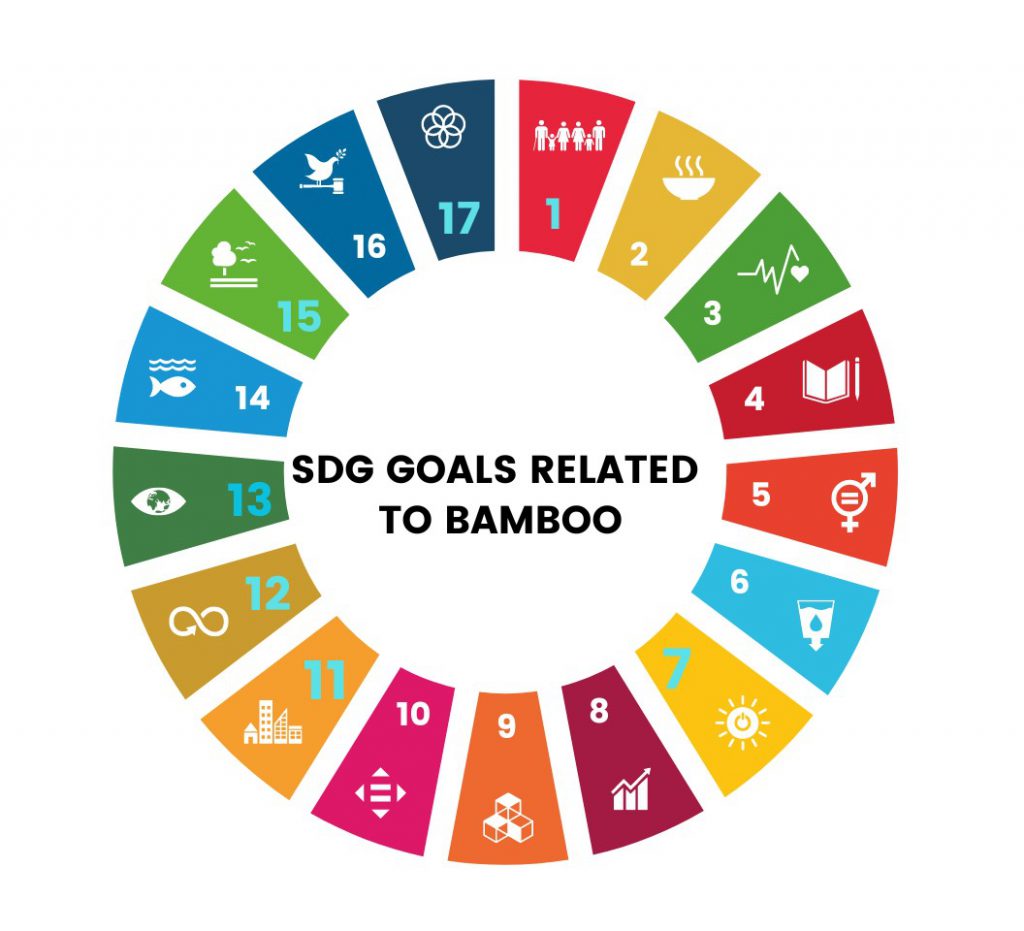
- SDG 12 (Responsible Consumption and Production): Every part of the bamboo plant can be utilized to manufacture various products, and many used bamboo products can be recycled for other purposes.
- SDG 13 (Climate Action): Bamboo plays a significant role in regional and global carbon cycles and carbon sinks, offering substantial carbon sequestration potential. Moreover, it has been effectively employed in absorbing wastewater from agriculture and related industries. Consequently, bamboo is considered an ideal candidate for reducing atmospheric carbon dioxide concentrations and mitigating the adverse effects of climate change.
- SDG 15 (Life on Land): Bamboo contributes to biodiversity conservation, providing habitats for threatened species such as the Red Panda in the Himalayan region and the Giant Panda in southern China. Additionally, it offers refuge to various amphibian and avian species. The extensive root and robust rhizome systems of bamboo also make it an effective tool for controlling erosion, maintaining slope stability, and preventing landslides.
Way Forward
Bamboo holds great potential as a Nature-based Solutions (NbS) to tackle a wide range of environmental challenges, including climate change, soil erosion, and water management. Expanding bamboo cultivation to private lands can enhance its geographic distribution, while providing training on bamboo-related products for rural communities can address livelihood vulnerabilities.
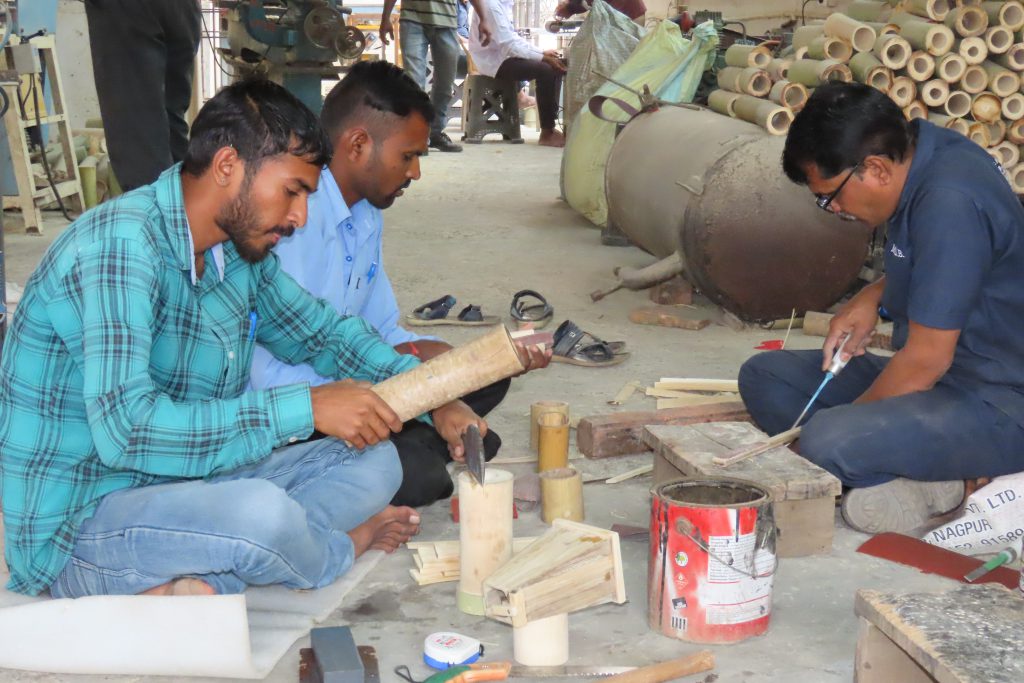
Under its Livelihoods theme, the Watershed Organisation Trust (WOTR) has recently ventured into a green livelihoods initiative, empowering villagers to cultivate and utilize bamboo to fulfill their timber and various other needs. This strategy not only enhances the local microclimate but also bolsters the financial stability of the village.
Further Reading
- Ahmad, Zishan et al. 2021. “Bamboo: Origin, Habitat, Distributions and Global Prospective BT – Biotechnological Advances in Bamboo: The ‘Green Gold’ on the Earth.” In eds. Zishan Ahmad, Yulong Ding, and Anwar Shahzad. Singapore: Springer Singapore, 1–31
- Cohen-Shacham, Emmanuelle et al. 2019. “Core Principles for Successfully Implementing and Upscaling Nature-Based Solutions.” Environmental Science & Policy 98: 20–29.
- Das, Sutapa, and Parthasarathi Mukhopadhyay. 2018. “Multi-Hazard Disaster Resilient Housing with Bamboo-Based System.” Procedia Engineering 212: 937–45.
- ISFR 2021. India State of Forest Report Forest Survey of India. Ministry of Environment, Forest and Climate Change, Government of India, Dehradun, India.
- Galmarini, Bianca, Paolo Costa, and Leonardo Chiesi. 2022. “Natural Building Materials and Social Representations in Informal Settlements: How Perceptions of Bamboo Interfere with Sustainable, Affordable, and Quality Housing.” Sustainability 14(19).
- Manandhar, Rashmi, Jin-Hee Kim, and Jun-Tae Kim. 2019. “Environmental, Social and Economic Sustainability of Bamboo and Bamboo-Based Construction Materials in Buildings.” Journal of Asian Architecture and Building Engineering 18(2): 49–59.
- Shimono, Kohei et al. 2022. “Differences in Net Primary Production Allocation and Nitrogen Use Efficiency between Moso Bamboo and Japanese Cedar Forests along a Slope.” Journal of Forest Research 27(1): 28–35.
- Song, Qing-ni et al. 2017. “Accessing the Impacts of Bamboo Expansion on NPP and N Cycling in Evergreen Broadleaved Forest in Subtropical China.” Scientific Reports 7(1): 40383.

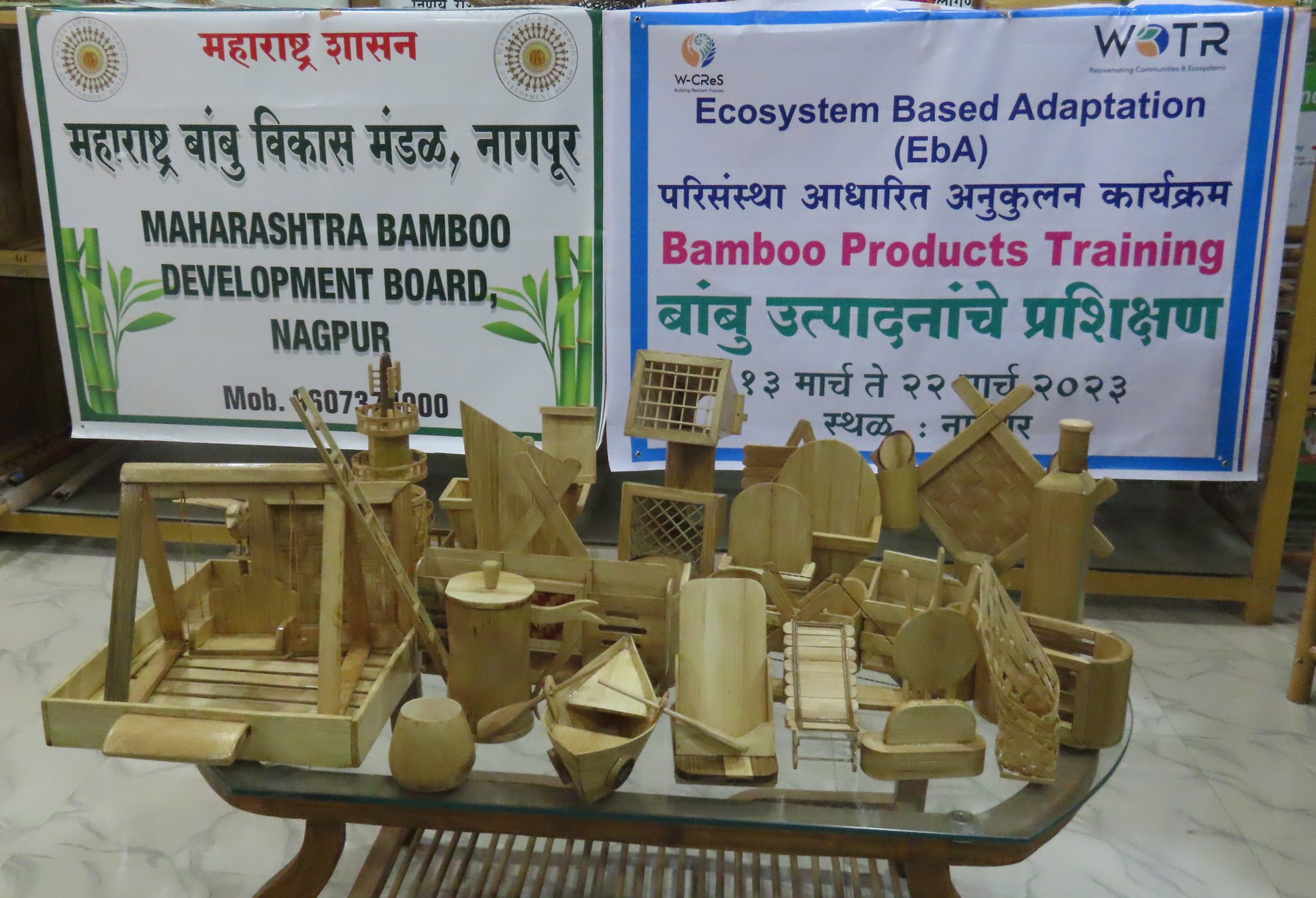





1 thought on “Bamboo: Harnessing Green Gold as a Nature-based Solution for a Sustainable Future and Improved Livelihoods”
The gift that keeps on giving is bamboo, a resource that grows quickly and is renewable.